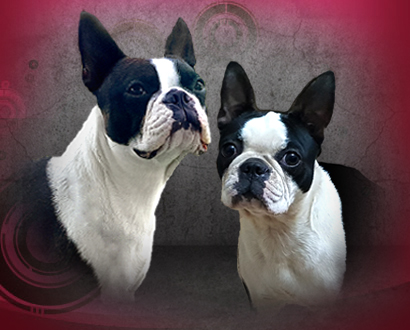|
History and some facts about the Boston Terrier
The Boston Terrier has its beginnings in Boston, located in the United States.
Around the year 1870, crossbreeding between English Bulldogs and English
Terriers led to a few other breeds. One of the first such dogs was named, Hooper's
Judge. He was bred with a white female, resulting in the first of the Boston
Terriers, although they did not go by that name until later.
In 1889, the American Bull Terrier Club was organized by owners of this new
breed of dogs. Unfortunately, the founders of this club met with some opposition
from both Bull Terrier and Bulldog owners. They did not believe that it was fair to
consider this new breed in the same standing or to use the same name as their
established breeds. The club quickly changed the name to the Boston Terrier Club.
Originally, crossbreeding produced inconsistent results and it took long years of
selective crossbreeding, including inbreeding, before consistent results were
achieved. Eventually, the breed became what it is today.
The Boston Terrier is known for his friendly nature that makes him a wonderful
companion. He does well in apartments and living with single people. However,
he is equally adaptable to family living since he does get along well with children
if there is a mutual respect between the child and the dog taught from an early age
to both.
The Boston Terrier is an intelligent breed, however can be very stubborn, sometimes
making him difficult to train. He enjoys spending time with people and being indoors
is quite acceptable to him. This breed is extremely sensitive to changes in
temperature (heat and cold). Additionally, he is loyal and empathetic to his owners
and their needs. As a watchdog, he is excellent and reliable. He is always alert to
any changes and is quick to respond.
Healthy Boston Terriers do not need lots of exercise to keep them happy and content.
However, moderate exercise that includes walks and some play are important. Regular
walks and exercise, on a moderate level are important not only to the dog's physical
health, but also, to his mental health. However, it is important to remember this breed's
tendency to have respiratory problems and to keep his exercise to short sessions that do
not involve overexertion on the part of the dog and never in extreme heat.
Puppy socialization classes are strongly advised.
The average lifespan of the Boston Terrier is between ten and fifteen years.
Hereditary conditions
Health issues that commonly affect the Boston Terrier include, juvenile hereditary
cataracts (JHC), deafness, heart murmurs, hypoplastic tracheas and patellar luxation
(knee cap dislocation/slipping patella).
Respiratory problems are also very common with Brachycephalic breeds (dogs that
have short muzzles or flat faces) like the Boston Terrier, as the nose bones are shortened
in these breeds and space is restricted. Therefore, this breed might experience breathing
difficulties during extremely hot weather.
All Boston Terriers carry the piebald ("white") gene and this gene has been linked with
deafness in many dog and cat breeds. In the case of the Boston Terrier, it is responsible
for the white markings (blaze, collar, chest, front legs and feet) and is referred to as the
Irish Spotted pattern.
Bostons that have more white than the above white markings, e.g. full white heads, white
bodies with black spots, blue eyes carries extreme piebald and SHOULD NEVER BE
BRED and should be BAER tested for hearing to establish if the dog can hear to enable
the new owner to make an informed decision regarding the puppy, as a bilaterally deaf
dog creates a burden some families cannot cope with.
Some minor issues include cherry eyes and allergies.
Brachycephalic breeds also experience "reverse sneezing" which is completely normal
and just a way for the dog to clear any foreign objects or irritants from the airway.
|
 |





